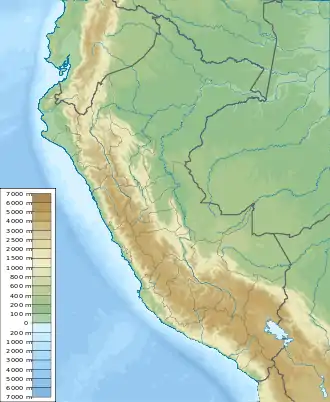Pongo de Mainique
The Pongo de Mainique is a water gap (canyon) of the Urubamba River in Peru. Inside the water gap, the river is constricted to a width of 45 metres (50 yd). The Pongo de Mainique is 3 kilometres (2 mi) long. The elevation of the river is approximately 450 metres (1,480 ft). The steep cliffs on each side of the river rise sharply to mountains with elevations of more than 1,200 metres (3,900 ft).[1][2][3]
| Pongo de Mainique | |
|---|---|
_(14780168924).jpg.webp) Thirty-foot canoe in a rapid above Pongo de Mainique. (1916) | |
 | |
| Location | La Convención Province, Cuzco Echarate and Megantoni districts |
| Coordinates | 12°14′15.72″S 72°49′18.73″W |
| Length | 3 kilometres (2 mi) |
| Width | 45 metres (50 yd) |
The Pongo de Mainique is the only break in the Vilcabamba mountain range. It also divides the Urubamba River (a headwater of the Amazon River) between the turbulent Upper Urubamba and the more placid Lower Urubamba. It is considered the most dangerous whitewater pass on the Urubamba; however, many boats traverse it, depending on seasonal river conditions. According to legend, the river was once crossed by the so-called Inca Bridge, although the Pongo was outside the boundaries of the Inca Empire. The bridge no longer exists.
The Pongo de Mainique is a global biodiversity hotspot. According to the Wildlife Conservation Society, "the lowland rainforests and mid-montane cloud forests within a radius of five miles (8 km) of the Pongo possibly comprise the single most biologically-diverse site on the face of the Earth." [4]
The rapids of the Pongo de Mainique were used as a filming location for key scenes of Werner Herzog's 1982 film Fitzcarraldo starring Klaus Kinski.[5] In a 2006 survey of "15 of the world's top travel writers" by The Observer, Monty Python actor and BBC travel documentarist Michael Palin named it his "favourite place in the world".[6]
References
-
Stromquist, Tamara (2000). "Paititi (ARA Winter 2000)". Macaw Landing Foundation's Ecotourism. Archived from the original on 2007-08-10. Retrieved 2007-08-18.
Onward we went to Pongo de Mainique, a 50-yard (46 m)-wide, two-mile (3 km)-long canyon through which flows the Urubamba River on its way from Cusco. This canyon is the only break in the entire Vilcabamba Mountain Range. The canyon has 3,000-foot (910 m)-high walls, 30 veil-like waterfalls and is extraordinarily beautiful.
- Llama Travel. "Cusco Tourist Information". Peru Tourist Information. Archived from the original on 2008-05-13. Retrieved 2008-07-18.
The Pongo de Mainique, a long, but beautiful, bus ride from Cusco, is a narrow gorge, with 300 m-high cliffs on either side of the Urubamba River, with waterfalls pouring down into the river.
- Google Earth
-
Wildlife Conservation Society (2001). "Surveys and protection of endangered wildlife in the Pongo". Macaw Landing Foundation's Field Projects. Archived from the original on 2007-08-13. Retrieved 2007-08-18.
WCS wishes to protect the Pongo because the lowland rainforests and mid-montane cloud forests within a radius of five miles (8 km) of the Pongo possibly comprise the single most biologically-diverse site on the face of the Earth.
- Source requiring two languages:
- Herzog, Werner (1999). "Spanish captions of documentary My Best Fiend from 27:58 to 28:37". My Best Fiend (German: Mein liebster Feind - Klaus Kinski). Archived from the original on 2007-08-17.
[Spanish captions keep "Mainique"] A unos días de viaje del Machu Picchu más abajo del río Urubamba. Aquí en el estrecho de las cataratas del Pongo de Mainique rodamos partes de la película "Fitzcarraldo". En la temporada seca, con agua baja no hay ningún peligro por aquí.
- Herzog, Werner (1999). "English captions of documentary My Best Fiend from 27:47 to 28:25". My Best Fiend (German: Mein liebster Feind - Klaus Kinski). Archived from the original on 2007-08-17.
[English captions omit "Mainique"] A few days journey from Machu Picchu, down the Urubamba river. Here, at the rapids of the Pongo, we shot parts of "Fitzcarraldo". During the dry season, with the water at its lowest level this is quite harmless.
- Herzog, Werner (1999). "Spanish captions of documentary My Best Fiend from 27:58 to 28:37". My Best Fiend (German: Mein liebster Feind - Klaus Kinski). Archived from the original on 2007-08-17.
- Wilkinson, Carl, ed. (2006-01-08). "My favourite place in the world". The Observer. Retrieved 2007-08-18.CS1 maint: multiple names: authors list (link) CS1 maint: extra text: authors list (link)
External links
- Pictures and text
- Palin, Michael (1997). "Day 193: Pongo De Mainique, Urubamba River". Full Circle. – Click "Next page" for two more screens.
- Pictures
Vanackeren, Guy (2003). "Kiteni et le Pongo de Mainique". Aventura Latino Americana (in French). – Pictures of the Pongo de Mainique (4th to 8th)